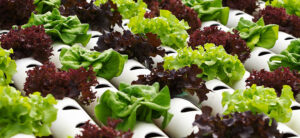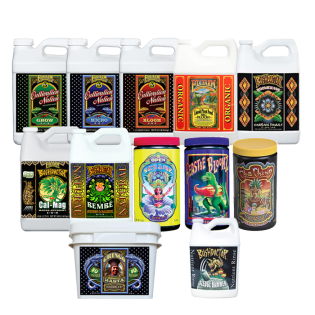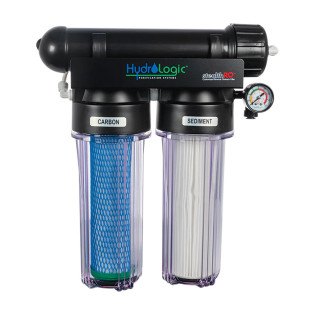
One of the most hotly contested debates in agriculture has been that of organic hydroponics. Is it truly possible to cultivate soilless plants organically?
You may be thinking, of course it is - I can just feed my hydro plants an organic nutrient solution, right? In the past, this wasn’t really possible because organic nutes were thick, and clogged systems.
But these days, natural plant nutrition has evolved to the point where this is less of a concern. There are all kinds of organic formulations that claim to be suitable for hydroponnics.
And yet, many growers claim that organic growing will never actually be possible through a hydroponics system.
We’ll explore this debate in depth, and take a look at arguments from both sides of the fence to finally put this debate to rest.
We’ll then give our recommendation on how you should proceed if you’re interested in giving this approach to horticulture a try! Let’s start with some definitions.
What Is Organic Hydroponics?
Organic hydroponics combines two cultivation techniques that are highly touted in their own regards - organic cultivation, and hydroponic cultivation.
For those who are new to the wide world of horticulture, we’ll quickly define each of these and give some background information.
What Is Organic Growing?

Some people have different definitions of what is truly considered organic, which is where the debate behind organic hydro cultivation comes into play.
But, organic growing is simply a cultivation style that omits any synthetic additives or genetic engineering.
This means no synthetic plant nutrients, and of course, no synthetic pesticides. This is a much tougher approach to growing, because it means you have to have your integrated pest management strategy dialed in to prevent you from ever having to use pesticides or fungicides in the garden or grow room.
Organic plant nutrients are also not quite as easy to feed, as they are delivered slower. This means it takes longer for nutrient deficiency to show itself, and longer to correct as well. However, there is a reason so many growers prefer natural cultivation methods.
Benefits Of Organic Growing
The biggest benefits of organic growing can all be summarized as “cleaner crops”. It goes without saying that using only natural, organic fertilizers produced a more natural, better tasting & smelling crop.
Synthetic fertilizers can overpower the natural flavonoids and terpenes of a plant that give it it’s taste and smell. By sticking to organics, you can avoid this downfall.
Obviously, organic growing is also safer and healthier for the environment and the consumer of your plants.
Synthetic pesticides, in some cases, can leave behind residuals in your plant that you then ultimately consume.
Organic growing also has a serious impact on the environment, in a very beneficial way. One aspect of this approach many growers don’t put enough focus on is the soil.
When growing organically, you tend to grow in soil. The goal is to improve the health of your soil over the course of time, and your soil becomes healthier and healthier.
When growing commercially, the impact synthetic products can have on your soil and atmosphere can be very detrimental.
What Is Hydroponics?

Now, let’s discuss the second half of this equation and define hydroponics. This one is far easier to describe - it’s an approach to cultivation that doesn’t use soil.
Instead, inert media such as coco, rockwool, or clay pebbles is used to anchor plants in place. Depending on the type of system you use, your plants will be fed a hyper-concentrated nutrient solution directly to their roots.
In DWC systems, plant roots are suspended in nutrient solution at all times, whereas in an ebb and flow system, nutrient solution periodically floods the roots, before draining back out on a cycle.
Then you have hydroponic drip systems, which feed plants from the top down using little emitters - very similar to drip irrigation. A fourth type worth mentioning - that is actually it’s own subset of cultivation - is aeroponics.
This is a bit different from hydroponics, but usually gets lumped into the same category. Here, plant roots are suspended in air, and sprayed with nutrient solution via fine emitters.
Benefits Of Hydroponics
There is definitely a steep learning curve with hydroponics, but it has plenty of benefits. For one, you are able to supercharge plant growth by dialing in nutrient concentration & uptake.
Because plant roots are so oxygenated - usually with an air stone and pump - plants can uptake nutrients far more efficiently, and thus, grow to their full genetic potential.
Hydroponics is also a style of growing that, once you get the hang of it, can be automated to a certain degree, leaving you with just the two chores of plant training and reservoir management.
With the absence of soil, plants grow cleaner with lower risks in terms of pests & diseases, particularly those that are soil-borne.
If you're new to this style, we encourage you to check out our complete guide to growing hydroponically. It will provide you with everything you need to know to feel confident starting yourself.
Is Growing Organic Hydroponics Plants Actually Possible?
Now, you have a good idea of what growing organically & hydroponically at the same time entails - you simply have to marry the two techniques we described above.
This sounds simple enough, right?
Well, according to the experts, maybe not. Let’s start with the debate against organic hydroponics.
The Debate Against Organic Hydroponics

For the most part, there are only two real arguments against this style - the soil dilemma and the availability of nutrients.
Some suggest you physically cannot grow organically in these systems due to the thick, clumpy nutrients you’ll have to use. And even if you could - there are no soil-dwelling bacteria to help break down the nutrients, right?
The Soil Dilemma
By far the biggest debate against this style of growing is the absence of soil. One of the key aspects of organic gardening is soil health - and as there is no soil in a hydroponic system, it fails to meet the mainstream definition.
This means the growing environment is incredibly sterile - great for hydroponics, but bad for organic growth, which relies heavily on microbial activity in the soil. With no microbial activity in your hydro system, plants will have a hard time readily taking up nutrients.
Sure, hydroponic growers can make up for this lack of natural microbial activity by feeding organic additives. But it’s tough to attain that same level of microbial life in a hydroponic system no matter how you shake it.
Organic Nutrients Are Too Thick For Hydroponic Systems
The other main reason organic hydroponic grows have failed in the past, and thus, get a bad name, is because of the thick, clumpy nature of organic plant fertilizers.
Because natural nutes aren’t fully soluble, they can easily clog up systems. This will lead to an accumulation/film of nutrients throughout your lines too, which creates problems with nutrient uniformity throughout the system.
Aside from the thick base nutrients themselves, you’ll also be dealing with sticky additives like sugars, molasses, microbes, etc.
With that said, this is a pretty minor complaint. If you really want to grow hydroponically and organically at the same time, it's not too much work to clean your system on a weekly basis to prevent this build up and scaling.
Nutrient Buildup Leads To Increase In Anaerobic Conditions
Over time, the nutrient build up leads to a decrease in aerobic conditions in your reservoir. This means oxygen is less available.
Two things will occur as a result of this - your roots will begin drowning without ample oxygen, and the likelihood for pathogen colonization in your system increases.
Both of these things can occur in a traditional hydro setup too, but in this situation, the solution is simply adding a product like UC Roots to your lineup to clear out the lines and keep things running smoothly.
As you might guess, these types of acidic, chemical cleaners are not suitable for an organic grow, however.
Organic Nutrient Uptake Is Lower In Hydroponic Systems
Finally, growers report that even if you can feed your hydroponic plants organic nutrients, doing so will be ineffective due to low uptake capabilities.
However, this is only if you try and grow organically in the wrong type of hydroponic system without creating a biofilter. We'll spend a good chunk of the article discussing the solution to increasing organic nutrient uptake in hydroponic systems!
The Debate For Organic Hydroponics

With all that said, there are still plenty of proponents for organic hydro cultivation. Some of their biggest arguments for this method are as follows:
Hydroponics Is Far More Water & Fertilizer Efficient Than Soil Growing
If organic cultivation is all about protecting the environment and being more efficient with our resources, hydroponics certainly meets the standards in terms of water usage!
Compared to soil cultivation, hydroponics uses far less water. This is especially true in RDWC (recirculating deep water culture), where the nutrient solution only has to be changed out every 1-2 weeks.
The same goes for nutrient concentrations. Because your plants are fed a far more concentrated nutrient solution, you are able to stretch your nutrient regimen further.
Hydroponics Can Turn Ecologically Dead, Urban Areas Into Thriving Gardens!
Speaking of getting the most out of our resources, let’s consider another huge benefit of hydroponics - the ability to cultivate plants anywhere you please.
As society progresses, we are inevitably decreasing our available farmland - and thus, eventually, we’ll have no choice but to turn to hydroponics.
These days, someone living in the middle of urban chaos - like NYC or LA - can still cultivate a garden indoors on a balcony or in a spare bedroom. And, they can usually do so more efficiently while producing crops quicker!
You Can Still Feed Hydroponic Plants Organic Fertilizers
While the soil dilemma isn’t going anywhere, you can still grow organically in a hydroponic setup by feeding organic fertilizers.
We mentioned that this used to be a tougher task, as thick organic nutrients could easily clog hydro lines, causing system failure and starving your crops.
However, with hydroponic growers in mind, manufacturers have formulated easy-to-use organic nutrients just for this type of cultivation.
Some of these are even OMRI certified, meaning they are tested to the highest of standards and still deemed to follow organic gardening protocols.
However, the system type and grow media you implement matters if you’re goal is to grow big, heavy plants organically & hydroponically.
The Verdict From The National Organic Standards Board of the USDA
We can weigh both sides all day long, but why not just look at what the NOSB (National Organic Standards Board) of the USDA (United States Department of Agriculture) has to say on the matter.

In 2017, they ruled that some hydroponic crops can in fact be deemed organic - and thus, get the organic label on their crops.
As you can imagine, the traditional organic crowd was less than pleased, while the hydroponic enthusiasts rejoiced.
So, with the debate seemingly settled, let’s explain how we recommend you grow your hydroponic plants in an organic manner.
Growing Hydroponically With Organic Nutrients
If you’re going to try growing hydroponically with organic nutrients, you’re going to be fighting an uphill battle - it won’t be easy. But, it’s certainly achievable!
The first step is determining whether or not your system is capable of following an organic regimen. Then, you need to determine how you’re going to supplement the grow with the rich microbial population they need in an organic environment.
Choose Your Hydroponic System
If you already have a hydroponic system, you are ahead of the curve. Otherwise, we recommend you read our year end review of the top hydroponic systems currently on the market.
There, we explain the differences between each type of system, and provide picks for every type of grower. But for organic environments, aquaponics or aeroponics tends to be the go-to system type.
These can be optimized specifically for organic growing, but particularly aquaponics. You can house fish in your system, and their feces will provide natural, organic fertilizer with microbial activity!
With that said, you can just as well use an ebb & flow, drip, or DWC system organically - it’ll just require a bit more work on your part. We’ll explain why later on.
Whether you’re a hobbyist looking for a small system, or a commercial cultivar considering outfitting a warehouse - we have something for you.
We carry the top brands at the best prices online, and with world class service that has industry leading growers working with us project after project, and even setting up automated reorders with us on their essentials like nutrients, media, etc.
Once you’ve got your system sorted out, then you’ll have to select an organic nutrient package and come up with a method of making these nutrients available to your plants.
Choosing An Organic Nutrient Package
Just like our top hydro article, we have a year end review of the best hydroponic plant nutrients as well - we go over soil nutrients, hydro nutrients, and organic nutrients.
But, what about organic hydroponic nutrients? Some of our favorite hydroponic nutrient packages that also happen to be OMRI certified for organic growing are:
- Botanicare KIND Nutrient Package
- Growth Science Organic Nutrient Package
- Fox Farm Cultivation Nation 3 Part Nutrient Package
These are great nutrients for what we’re trying to do, but if they aren’t readily available to your plant, they’re useless.
So with that said, let’s move onto the next step - creating a biofilter to allow your plants easy access to these vital nutrients!
Create A Biofilter To Increase Nutrient Uptake

Like we said earlier, one of the big issues with organic hydroponics is the lack of soil dwelling bacteria and microbial activity.
These little guys take the large, organic molecules you feed your plant and break them down into more readily available forms, allowing your plant to uptake them.
As you know, these conditions will not exist naturally in your hydroponic system. Thus, you need to provide a “biofilter”. This must be accompanied with ample aeration, via an air stone and air pump combo.
Choose A Hydroponic Grow Media
Creating a biofilter is as simple as creating enough oxygenation near the root zone. Adding an inert grow media is essential for this.
Something like clay pebbles or coco will work great. You’ll also need a net pot/cup to hold the roots and grow media altogether.
What will happen over time is colonies of bacteria and microbes will begin forming on your grow media, and they’ll help take the nutrient solution and turn it into something more usable for your plants. Everyone wins!
Maintaining Your Organic Hydroponic System
Put this all together and add plants, and you’ve got a thriving hydroponic crop, cultivated entirely by organics.
Of course, you’ll likely go through some trial and error as it pertains to nutrients & pH. Many growers report huge swings in pH when feeding organically in a hydroponic system.

This means you’ll have to constantly monitor and adjust pH. Or, you can save yourself the hassle by investing in an automated nutrient & pH dosing system.
These are essential for commercial growers who have an investment on the line and can’t afford any room for error. They’ll provide around the clock monitoring and control of your nutrient reservoir, keeping your plants healthy and happy - while automating one of the toughest aspects of growing.
From there, you’ll just have to worry about safely descaling your reservoir and preventing any excessive nutrient buildup along the walls of your reservoir. Because you’re using organic inputs, this will be less of a problem compared to salt-based synthetic nutrients.
Follow Organic Cultivation Guidelines As Much As Possible
It should go without saying, but we also want to remind you that you need to follow all organic guidelines throughout your grow.
This means no synthetic pest control products, and you have to be careful about anything you use to clean your hydroponic reservoir or lines.
Final Thoughts On Organic Hydroponics
We’ve weighed both sides of the debate over organic hydroponics, and explained exactly how you can go about giving this a try yourself.
All that’s left to do is grab your equipment and supplies, find your seeds or clones, and get to growing!















































